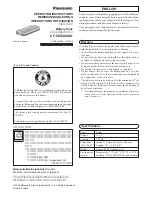
10
9.0113
Battery charger type BC120202, BC120263, BC120403, BC120603, BC120803, BC240303, BC240503, BC240803
3
For your own safety
3.1
General
Warning!
Highly dangerous currents can arise in the battery
charger!
The charger may only be opened and repaired by an
electrician.
Before opening the battery charger, always disconnect
it from the mains voltage and the battery.
Tip!
If the safety precautions are not observed during use
of the battery charger, then all forms of guarantee and liability of
the manufacturer/supplier will lapse.
3.2
Use
The battery charger is exclusively designed for charging
lead/acid batteries. Depending on the setting, fluid filled batter-
ies or gel filled batteries can also be charged.
The batteries can be open or closed and starting batteries or
semi-traction batteries.
Please observe the following instructions from the manufactur-
er.
The battery charger is not suitable for all other batteries and
non-chargeable batteries!
The battery charger may only be used in technically perfect
condition. If malfunctions occur that can affect the safety of user
and ship, the battery charger must immediately be turned off.
For safety reasons, amendments to the apparatus are prohibit-
ed.
Repairs (e.g. replacing the direct current fuse) may only be car-
ried out by persons skilled in such.
Safety earthing must be observed.
4
Installation
4.1
Installing
Choose a dry place at considerable distance from a heat
source.
High temperatures can negatively affect the capacity of the
apparatus.
Therefore never cover the ventilation openings and keep a
space of at least 10 cm free around the battery charger.
Do not place the battery charger too far from the battery in order
to restrict the loss of voltage on the (12 volt resp. 24 volt) con-
nection wires as much as possible. If necessary, it is better to
lengthen the 230 volt lead. Do not place the battery charger
directly above the battery; sulphurous battery fumes could
cause damage to the electronic parts.
The apparatus meets the protection level IP 20.
Use the drilling jig to determine the position of the fastening
holes and affix the battery charger to a wall in vertical position
with the connections downwards, see also ‘12 Main measure-
ments’.
Do not drill any extra fastening holes in the metal
casing!
The presence of small metal particles in the battery
charger can cause irreparable damage.
4.2
Battery connections
Warning!
First disconnect the mains voltage before connecting
or disconnecting the batteries.
N.B.!
The battery current must correspond with the details on
the battery charger!
Refer to the ‘11 Electrical circuit diagrams’ to see how the bat-
tery charger must be connected to the batteries.
Use cables of sufficient thickness and use cable sockets, see ‘8
Cable selection table’ for the correct cable diameter.
It is advisable to use short shielded or twisted battery
cables to comply with CE guidelines.
Warning!
Large currents flowing through wires that are too thin,
or transfer resistances caused by bad connections can
lead to wires or (plug) connections becoming extreme-
ly hot and causing fire.
N.B.!
When connecting the charger to the battery observe
the correct polarity!











































